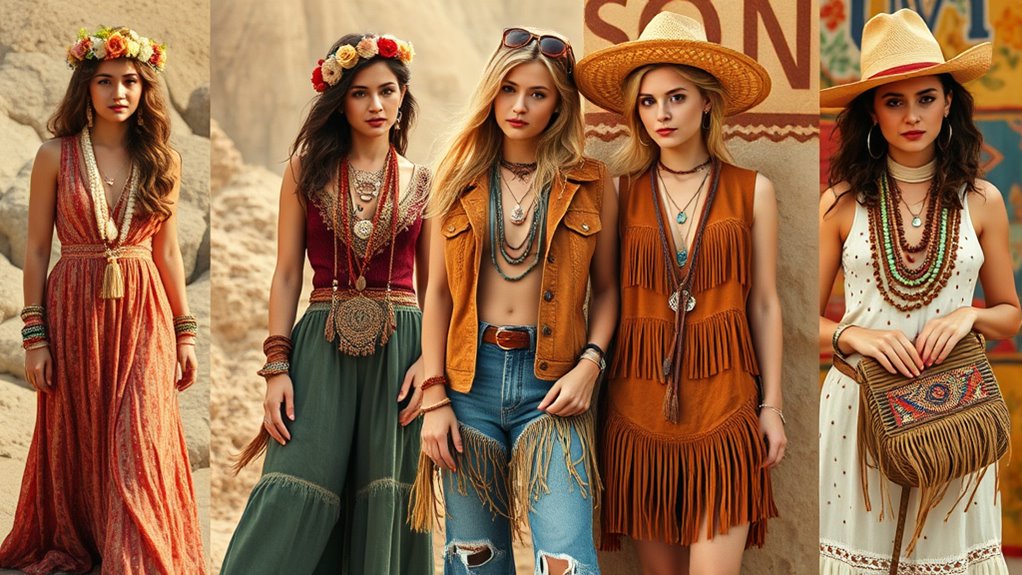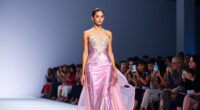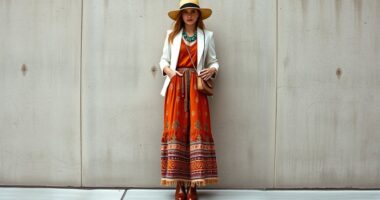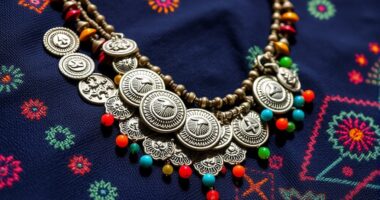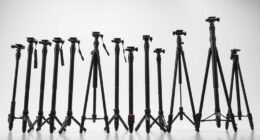The evolution of boho style takes you from its roots in the 1960s counterculture and hippie movement, where ethnic prints, flowing fabrics, and handcrafted accessories symbolized freedom and rebellion. In the 2000s and 2010s, celebrities and designers revived and reinvented it with a modern, sustainable twist, blending vintage with contemporary fashion. Today, boho continues to evolve through cultural influences and new technologies. Keep exploring, and you’ll discover how this free-spirited style keeps transforming over time.
Key Takeaways
- Boho style originated in the 1960s counterculture, inspired by hippie ideals, ethnic prints, and free-spirited fashion.
- The 1970s hippie movement popularized layered fabrics, DIY techniques, and global influences like Native American and Middle Eastern motifs.
- Revival in the 2000s-2010s saw celebrities and designers blending vintage elements with modern fabrics, emphasizing sustainability and artisanal craftsmanship.
- Contemporary boho trends incorporate ethical, eco-friendly materials, digital innovations, and vintage-inspired pieces for a modern, sustainable aesthetic.
- Cultural influences from African, Middle Eastern, and Asian motifs continue to shape boho’s rich visual storytelling and global appeal.
The Birth of Boho: Roots in 1960s Counterculture
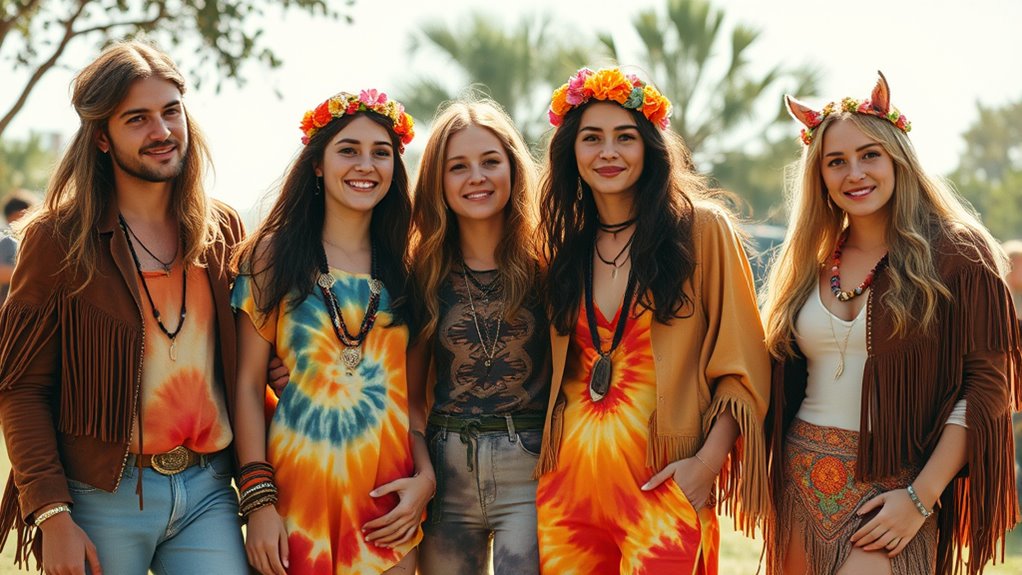
The birth of boho style in the 1960s emerged as a bold response to conventional fashion, driven by the hippie movement and counterculture ideals. During this era, you’d notice a shift toward more relaxed, expressive clothing that rejected mainstream norms. The movement embraced ethnic prints, embroidery, fringe, and flowing fabrics inspired by global and indigenous cultures. Icons like Janis Joplin and Stevie Nicks popularized this free-spirited look, making it a symbol of individuality. Festivals like Woodstock in 1969 played a pivotal role in spreading boho fashion, with maxi dresses and handmade accessories becoming widespread. This style reflected the movement’s core values—peace, love, and a deep connection to nature—marking a rebellion against materialism and traditional societal standards.
Key Influences From the 1960S and 70S Hippie Movement
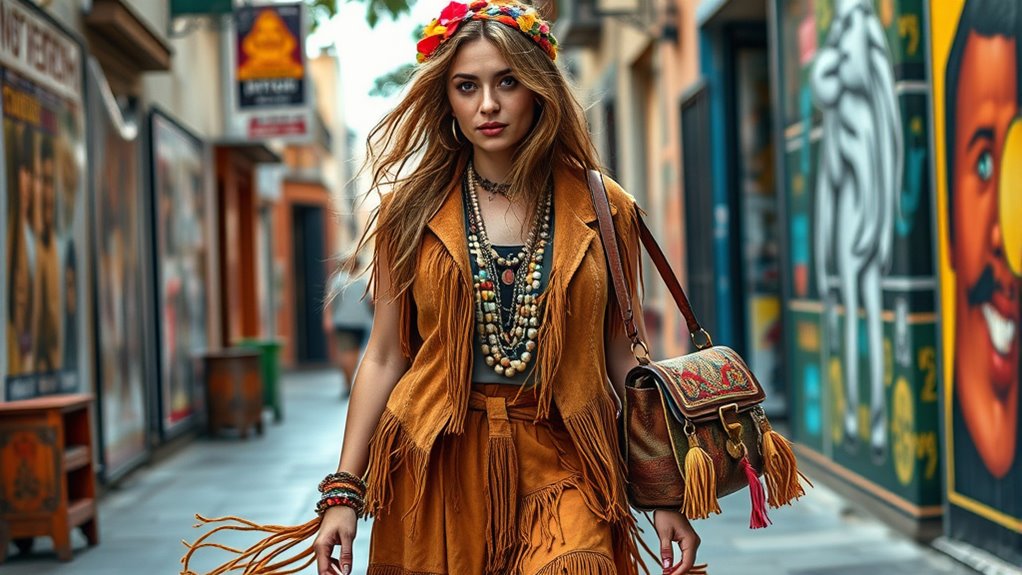
You can see how the 1960s and 70s hippie movement profoundly shaped boho style by embracing ethnic prints, embroidery, fringe, and flowing fabrics that symbolize peace, love, and cultural diversity. The movement’s influence is evident in several key ways:
- It popularized ethnic prints and layered fabrics inspired by Native American, Middle Eastern, and Asian aesthetics.
- DIY fashion became central, with tie-dye, patchwork, and macramé emphasizing personal expression.
- Festival culture, especially iconic events like Woodstock, introduced maxidresses, caftans, and folkloric attire into mainstream style.
- Prominent figures like Janis Joplin and Stevie Nicks embodied this eclectic, free-spirited look, cementing the hippie movement’s lasting impact on boho fashion.
- The cultural diversity embraced by the hippie movement continues to influence contemporary boho trends, blending global aesthetics into modern interpretations.
- Additionally, the use of vintage and retro elements remains a hallmark of boho style, reflecting its roots in the countercultural movements of the 1960s and 70s.
- The incorporation of natural materials like hemp, leather, and organic fabrics further underscores the movement’s emphasis on sustainability and harmony with nature.
- Modern boho style often incorporates eco-friendly practices, demonstrating a continued commitment to environmental consciousness rooted in the movement’s origins.
- The resurgence of spiritual symbolism in accessories and clothing highlights the movement’s ongoing connection to holistic and metaphysical beliefs.
Revival and Reinvention in the 2000s and Early 2010s
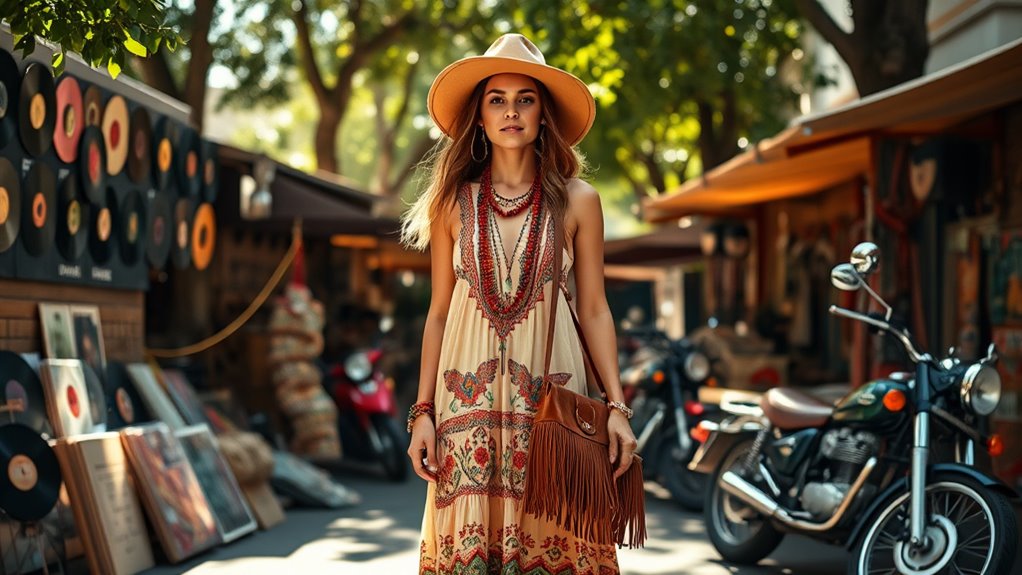
In the 2000s and early 2010s, celebrities like Sienna Miller and Kate Moss brought boho style back into the spotlight with festival-inspired looks. Designers blended vintage influences with modern fabrics, creating fresh takes on classic bohemian pieces, while magazines and retailers made these styles widely accessible. During this period, there was also a stronger focus on sustainability, with eco-friendly fabrics and artisanal craftsmanship shaping the reinvention of boho fashion. Additionally, the integration of sound design techniques into fashion presentations and campaigns helped emphasize the tactile and atmospheric qualities of boho aesthetics. Interestingly, the resurgence of boho style coincided with a broader cultural awareness of wealth and the desire for authentic, handcrafted fashion items. Many brands adopted eco-friendly and sustainable practices, resonating with consumers seeking environmentally responsible choices. This evolution also reflected a shift towards ethical production and transparency in sourcing materials. As the movement grew, the emphasis on inclusivity and diversity further broadened the appeal of boho fashion to a wider audience.
Celebrity Influence Resurgence
Have celebrities truly shaped the resurgence of boho style in the 2000s and early 2010s? Absolutely. Their influence sparked a boho-chic revival that seamlessly blended vintage-inspired looks with modern trends. Key figures like Sienna Miller and Kate Moss popularized layered, individualistic outfits, setting new standards for festival and streetwear fashion. Mary-Kate Olsen became an icon by showcasing maxi dresses, wide-brimmed hats, and layered jewelry, inspiring mainstream adoption. Additionally, the festival scene, especially Coachella, propelled boho styles into the spotlight with stars like Vanessa Hudgens and Gigi Hadid leading the charge. High-end designers, including Roberto Cavalli and Chloé, integrated boho elements into their collections, further legitimizing and reinventing boho style for contemporary audiences, driven mainly by celebrity influence. The celebrity-driven fashion trends displayed by these celebrities—such as creativity and openness—also contributed to the style’s dynamic evolution and lasting cultural impact. Moreover, the rise of social media platforms amplified these trends, allowing followers to emulate celebrity looks instantly and fueling the fashion movement even further. This digital shift made boho fashion more accessible and fostered a global community of enthusiasts sharing and reinventing the style.
Vintage Meets Modern Style
The 2000s and early 2010s marked a dynamic revival of boho style, where vintage-inspired pieces seamlessly blended with modern fashion trends. You could find bohemian elements like crochet details, embroidery, and wide-brimmed hats reimagined for contemporary tastes. Celebrities such as Sienna Miller and Kate Moss popularized layered, vintage looks with a modern twist, influencing mainstream fashion. Designers like Isabel Marant and Chloé incorporated antique motifs into their collections, creating a fresh, modern boho aesthetic. Thrift shopping and vintage stores became essential sources for authentic pieces, emphasizing individual expression and sustainability. This era reinvented classic boho style for a globalized, modern audience, making vintage and bohemian elements a staple in everyday fashion. Furthermore, the resurgence of interest in sustainable fashion encouraged consumers to seek out eco-friendly and ethically sourced vintage garments. Additionally, the integration of recycled materials into accessories and clothing lines exemplified the movement toward environmentally conscious fashion choices.
Emphasis on Sustainability
As boho style gained popularity in the 2000s and early 2010s, a strong emphasis on sustainability reshaped its evolution. You notice brands prioritizing eco-friendly materials such as organic cotton, bamboo, and recycled fabrics, making the fashion more sustainable. Designers incorporate digital printing techniques to minimize waste and produce vibrant, detailed patterns on eco-conscious textiles. Many brands collaborate with artisans and organizations to promote fair trade practices and ethical manufacturing processes. Additionally, consumers gravitate toward vintage and thrift shopping, supporting a circular fashion economy. This shift reinforces boho’s commitment to ethical fashion trends, emphasizing environmental causes, reducing waste, and using eco-friendly dyes. An understanding of sustainable textiles is crucial for appreciating the environmental impact of modern boho fashion. Furthermore, the adoption of eco-conscious production methods demonstrates a dedication to reducing the fashion industry’s carbon footprint. These efforts mark a significant turning point, blending style with sustainability for a more mindful fashion evolution. Recognizing the role of environmentally-friendly dyes highlights the importance of sustainable practices in textile production.
The Role of Celebrities and Fashion Icons in Popularizing Boho
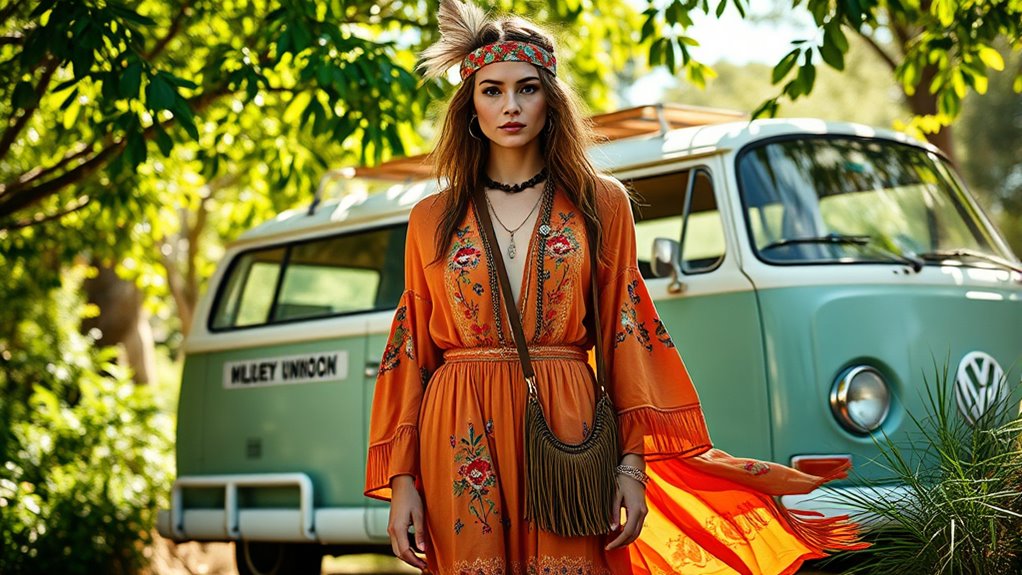
Celebrities and fashion icons have played a pivotal role in shaping and popularizing boho style over the decades. Their celebrity influence helped spark the boho revival, making free-spirited looks like fringe, flowing fabrics, and layered accessories mainstream. In the 1960s and 70s, icons like Janis Joplin and Stevie Nicks set the tone with their iconic, bohemian-inspired outfits. Fast forward to the early 2000s, Sienna Miller and Kate Moss brought vintage-inspired, chic pieces into the spotlight, influencing countless modern trends. Today, stars like Florence Welch and festival icons such as Gigi Hadid continue to shape boho’s evolution, blending ethereal, romantic styles with contemporary fashion. High-end designers, inspired by celebrity influence, incorporate boho elements into runway collections, cementing its place in modern fashion. Additionally, the distinctive aesthetic of boho style often draws inspiration from various cultural and historical sources, enriching its eclectic appeal. The cultural influences behind boho style contribute to its dynamic and ever-evolving nature, ensuring its relevance across generations. Moreover, the fashion industry actively promotes boho trends through seasonal collections and marketing campaigns, further cementing its popularity.
Sustainable and Ethical Practices Shaping Modern Boho Fashion

Modern boho fashion is increasingly driven by a commitment to sustainability and ethical practices, reflecting a shift in consumer values and industry standards. You’ll notice brands embracing eco-friendly materials like organic cotton, bamboo, and recycled fabrics. They also prioritize ethical practices by ensuring fair labor standards and collaborating with artisans worldwide to support fair employment and community development. To promote responsible consumption, brands adopt transparent supply chains and eco-conscious production methods, reducing environmental impact. Additionally, innovations like digital printing and low-waste manufacturing help minimize textile waste and energy use. A growing focus on safe electrical appliances and environmentally friendly manufacturing processes demonstrates the industry’s dedication to reducing health risks and environmental footprint. Incorporating attention to detail in design and production further enhances sustainability efforts. Here are some key trends shaping this movement:
Modern boho fashion champions sustainability through eco-friendly materials, fair labor, and innovative low-waste production methods.
- Use of sustainable materials
- Fair labor and artisan collaborations
- Eco-friendly production techniques
- Circular and responsible consumption strategies
Furthermore, increasing awareness of home decor and lifestyle can influence sustainable choices across fashion and interior design sectors.
Variations and Styles: From Boho-Chic to Edgy Boho Looks

The diverse expressions within boho fashion showcase its flexibility, allowing you to explore different moods and aesthetics. Variations like boho-chic emphasize vintage, ethnic, and artisanal elements, creating a relaxed, romantic vibe with flowing fabrics and layered accessories. Edgy boho introduces darker palettes, leather accents, and bold jewelry, giving a rebellious, modern twist to traditional styles. Modern boho focuses on versatile pieces such as kimono jackets, fringe details, and wide-leg trousers, suitable for both casual and dressier occasions. Whether you prefer a soft, feminine look or want to incorporate punk-inspired elements, boho styles adapt to your personal taste. These variations demonstrate how boho fashion continually evolves, offering endless ways to express your individuality. Additionally, understanding the history of boho fashion helps appreciate its roots and how it has transformed over the decades.
Incorporating Boho Elements Into Contemporary Wardrobes

Incorporating boho elements into your contemporary wardrobe is easier than you might think, thanks to versatile pieces and thoughtful styling. Start with these key ideas:
- Choose flowing fabrics like maxi dresses, layered with denim jackets or crochet cardigans for a modern boho-chic look.
- Mix vintage-inspired patterns such as paisley and floral with minimalist pieces to create a personalized, daily boho style.
- Add accessories like layered necklaces, wide-brimmed hats, or statement earrings to enhance your outfit with boho flair.
- Opt for eco-friendly materials like organic cotton or recycled fabrics that blend sustainability with style.
These elements seamlessly progress from casual daytime wear to polished evening outfits, making boho-inspired fashion both practical and stylish.
The Future of Boho Style: Trends and Cultural Inspirations
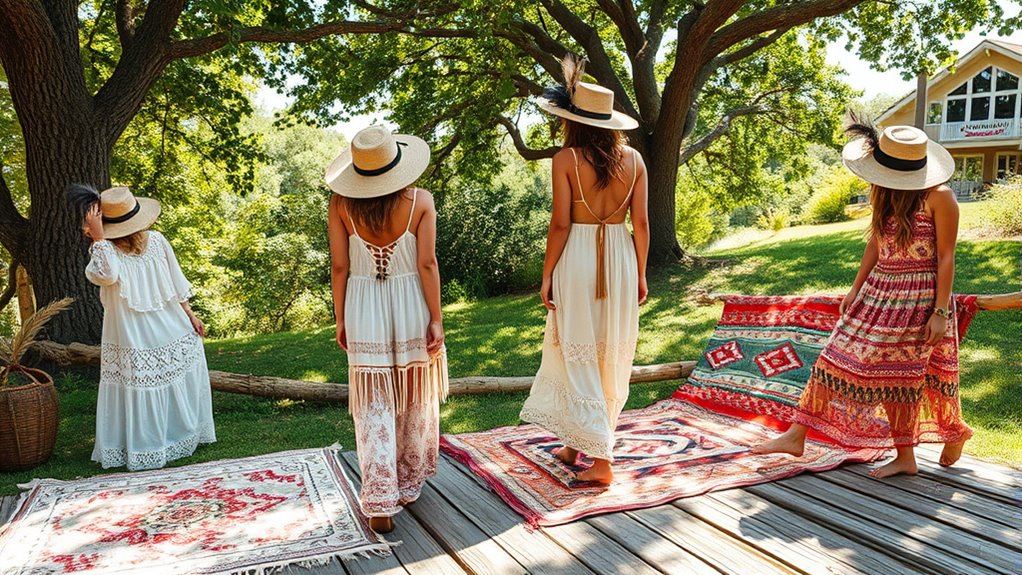
As boho style evolves, expect sustainability to take center stage with more eco-friendly materials shaping future designs. Cultural influences from around the world will blend seamlessly, creating diverse and vibrant patterns and textiles. Advances in digital fashion will enable personalized, functional pieces that reflect both tradition and innovation.
Sustainable Material Innovations
Innovations in sustainable materials are transforming boho fashion by offering eco-friendly options that don’t sacrifice style or individuality. You’ll see brands embracing sustainable materials like organic cotton, hemp, and bamboo, reducing environmental impact while maintaining boho’s free-spirited aesthetic. Recycled fabrics and digital printing enable vibrant, eco-friendly patterns that celebrate uniqueness. Emerging biodegradable fibers, such as mushroom leather and plant-based dyes, are shaping eco-conscious accessories and textiles. Additionally, companies investing in regenerative agriculture practices grow raw materials that promote biodiversity and soil health, enhancing sustainability. These innovations support boho’s core values of harmony with nature and ethical production, ensuring its evolution remains aligned with environmental consciousness. As a result, sustainable materials are paving the way for a more mindful, stylish future of boho fashion.
Global Cultural Influences
Sustainable material innovations are shaping boho fashion not only through eco-friendly fabrics but also by embracing diverse cultural influences that celebrate global craftsmanship. You’ll see designs inspired by African, Middle Eastern, Asian, and Indigenous traditions, integrating unique patterns, traditional textiles, and artisanal techniques. Cross-cultural collaboration fuels this trend, blending distinct aesthetics into cohesive collections that honor heritage and promote fair trade. This global influence encourages respect and authenticity, steering clear of cultural appropriation. Here’s a glimpse of how cultural motifs and textiles are shaping future boho styles:
| Cultural Influence | Key Features | Impact |
|---|---|---|
| African | Bold patterns, beadwork | Rich visual storytelling |
| Middle Eastern | Intricate embroidery, textiles | Luxurious, detailed accents |
| Asian | Silk, floral motifs, craftsmanship | Elegant, delicate details |
Digital Fashion Integration
Have you noticed how digital technology is transforming boho fashion? It’s revolutionizing how you experience and create this style. Here’s how:
- Digital printing allows for intricate, vibrant boho patterns on eco-friendly fabrics, promoting sustainability and reducing waste.
- Virtual fashion shows and online collections make boho styles accessible worldwide, eliminating the need for physical samples.
- Augmented reality enables you to virtually try-on boho pieces, enhancing your shopping experience.
- Blockchain technology supports ethical, sustainable production by authenticating and transparent supply chains.
These advancements help preserve boho’s free-spirited essence while embracing modern innovation, making the style more sustainable, personalized, and globally connected.
Frequently Asked Questions
What Is the Origin of Boho Style?
You’re curious about the origin of boho style. It started in the 1960s as a reaction to the stiff fashion of the 1950s, inspired by the hippie movement and counterculture ideals. Its roots go back to 19th-century European bohemian communities, where artists and creatives embraced unconventional, free-spirited clothing. Early boho fashion features flowing fabrics, earthy tones, layered patterns, and ethnic prints, reflecting artistic and cultural influences.
What Is the History of Boho Clothing?
You might find that boho clothing has a rich history rooted in 19th-century European artists and intellectuals who embraced loose, resourceful, and unconventional fashion as a form of artistic rebellion. During the 1960s hippie movement, it became a symbol of cultural expression with maxi dresses and ethnic prints. Over time, it evolved into a style representing free spirit, cultural diversity, and sustainable fashion practices.
What Is the History of the Boho Theme?
You might wonder about the history of the boho theme. It started in the 18th and 19th centuries among artists, writers, and thinkers in France who embraced unconventional, nomadic lifestyles as a form of rebellion. Over time, it evolved through Romantic art, 1960s counterculture, and influential icons, becoming a symbol of individuality, freedom, and artisanal craftsmanship that continues to inspire modern fashion and lifestyle choices today.
What Is the Difference Between Modern Boho and Boho?
Imagine you’re walking through a market—classic boho is like discovering vibrant, handcrafted textiles bursting with colors and layers, full of rebellious spirit. Modern boho, however, is like sleek, minimalist designs that still hint at boho’s free-spirited roots but with cleaner lines and eco-friendly fabrics. The main difference? Traditional boho emphasizes eclectic, layered looks, while modern boho focuses on versatile, polished pieces that suit urban lifestyles.
Conclusion
As you embrace boho style, remember it’s more than just fashion—it’s a movement rooted in freedom and creativity. Did you know that the global bohemian fashion market is projected to grow by over 8% annually? This shows how your unique, eco-conscious choices are part of a larger cultural shift. Keep experimenting with textures, patterns, and sustainable pieces—your wardrobe can tell a story that’s timeless and truly yours.

